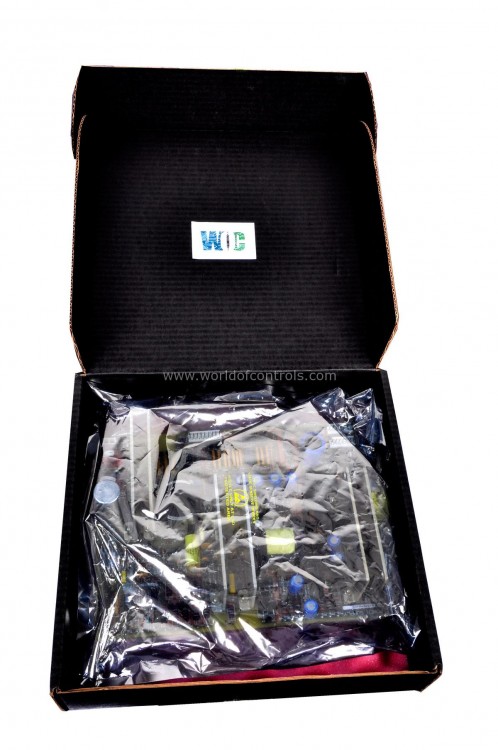SPECIFICATIONS
Part Number: IS200TFBAH1A
Manufacturer: General Electric
Series: Mark VIe
Function: Temperature Feedback Module
Temperature: -40 to +70 degrees Celsius
Voltage Rating: 24VDC
Product type: PCB
Availability: In Stock
Repair: 3-5 Days
Country of Manufacture: United States (USA)
Functional Description
IS200TFBAH1A is a temperature feedback module developed by GE under the Mark VIe control system. The module is a 16-channel, 24VDC component. It has 16 outputs, each capable of sinking up to 0.5 amps of current. This module is intended for use in harsh industrial environments and has a wide operating temperature range of -40 to +70 degrees Celsius. The Mark VIe control system offers a versatile configuration capability that empowers users to efficiently manage input selection and voting processes. It does so by employing a straightforward, yet highly dependable and efficient selection/voting/fault detection algorithm. This algorithm has been meticulously designed to streamline the configuration process, significantly reducing the effort required for setting up various applications.
System Overview
- The GE Mark VIe control system is a state-of-the-art platform for controlling and monitoring gas and steam turbines, as well as other industrial processes. It features a modular and scalable design that allows for easy customization and expansion, making it suitable for a wide range of applications.
- The system consists of hardware and software components, including the human-machine interface (HMI), controllers, I/O modules, and communication networks. The HMI provides operators with a graphical interface to monitor and control the system, while the controllers execute control algorithms and perform safety functions.
- The system is equipped with advanced diagnostic and predictive maintenance features that enable early detection of equipment issues and reduce downtime. It also supports remote monitoring and control capabilities, allowing for remote access to the system from anywhere in the world.
- It is widely used in the power generation industry, particularly in gas and steam turbine power plants, as well as in oil and gas production and other industrial applications. It is designed to meet the most demanding performance and safety standards, and is continuously updated with the latest technologies to improve system performance and reliability.
- By facilitating the selection and voting of sensor inputs, the Mark VIe control system maximizes the available reliability options for a given set of inputs. This means that users can tailor the system to meet specific requirements, ensuring optimal performance and robustness.
- The system ensures that this selection and voting capability is seamlessly integrated with the hardware, providing compatibility with output voting components. This harmonious synergy between input selection and output voting hardware creates a comprehensive and dependable control ecosystem.
- To make this feature even more adaptable, the Mark VIe control system allows users to apply these reliability options on a per-terminal basis. This means that users can fine-tune the system's reliability configurations according to their specific needs, all while maintaining a high degree of control over the Mark VIe topology.
Product Attributes
- Voltage Rating: This module is engineered to operate efficiently on a 24VDC power supply. This voltage rating ensures compatibility with standard industrial power sources and facilitates its integration into various control systems.
- Output Capacity: With a total of 16 outputs, each capable of sinking up to 0.5 amps of current, this module provides ample capacity to control and manage a wide array of devices and components within an industrial setup. Its high output capacity enhances its versatility and utility in industrial applications.
- Industrial-Grade Design: The module is purpose-built to withstand the rigors of harsh industrial environments. Its industrial-grade design ensures that it can endure challenging conditions, including temperature extremes, vibrations, and potential exposure to contaminants.
- Temperature Range: Operating effectively within a broad temperature range spanning from -40 to +70 degrees Celsius, this module is well-suited for applications that demand reliability in both extreme cold and hot environments. Its ability to function across such a wide temperature spectrum contributes to its adaptability.
- Durability: Built with durability in mind, this module is constructed to withstand the demands of long-term use in industrial settings. Its robust design and quality materials ensure that it can stand up to continuous operation and resist wear and tear over time.
- Compatibility: Ensures that it can be readily incorporated into existing control systems or used in conjunction with other GE Mark VIe components, simplifying the implementation process.
System Network Features
- The Mark VIe control system is built on a network hierarchy that connects individual nodes. These networks divide the various communication traffic into layers based on their individual functions. This hierarchy extends from the I/O modules and controllers that provide real-time process control to the HMI and facility wide monitoring. Each layer employs industry-standard components and protocols to simplify platform integration and improve overall reliability and maintenance.
- The Enterprise layer connects specific process control to a facility-wide or group control layer. The customer provides this higher layer. Depending on the size of the facility, the network technology used in this layer is generally determined by the customer and may include either local area network (LAN) or wide area network (WAN) technologies.
WOC is happy to assist you with any of your GE requirements. Please contact us by phone or email for pricing and availability on any parts and repairs.
FREQUENTLY ASKED QUESTIONS
What is IS200TFBAH1A?
It is a temperature feedback module developed by GE
How many channels does the module have?
The module has 16 channels.
How much current can each output of the module sink?
Each output of the module can sink up to 0.5 amps of current.
What is the operating temperature range of the module?
The operating temperature range of the module is -40 to +70 degrees Celsius.
